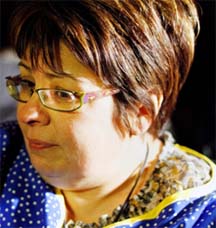OTTAWA, (Reuters) – A Canadian aboriginal chief in the third week of a hunger strike is urging Prime Minister Stephen Harper to “open his heart” and meet with native leaders angered by his policies as small impromptu protests spread beyond Canada’s borders.
Chief Theresa Spence from the remote northern Ontario community of Attawapiskat has been fasting since Dec. 11 and has vowed to continue until Harper personally commits to the talks on a litany of complaints, including new legislation that she says will harm native lands.

“He’s a person with a heart but he needs to open his heart. I’m sure he has faith in the Creator himself and for him to delay this, it’s very disrespectful, I feel, to not even meet with us,” she said in an interview in Ottawa.
Spence is at the center of an unprecedented Canadian aboriginal protest movement called “Idle No More” that began with four women in the province of Saskatchewan raising awareness about the Conservative government’s budget bill, which was passed earlier this month.
The bill, which has also been heavily criticized by opposition politicians for its broad reach, scales back environmental protections for lakes and rivers and makes it easier to sell reserve lands.
Aided by Facebook and Twitter, their protest proliferated faster than anyone had imagined and is now drawing comparisons to the “Occupy Wall Street” movement.
“Flash mob” protests with traditional dancing and drumming have erupted in dozens of shopping malls across North America.
There have been rallies, marches and highway blockades by aboriginal groups across Canada and supporters have emerged from as far away as New Zealand and the Middle East.
The campaign aims to draw attention to the dismal living conditions faced by many of the country’s 1.2 million natives, including poverty, unsafe drinking water, inadequate housing, addiction and high suicide rates.
‘I’M WILLING TO DIE’
Camped out in a traditional teepee within sight of Ottawa’s Parliament buildings, Spence appeared weak and short of breath but resolute on Thursday, Day 17 of her hunger strike, staying warm by a wood stove as a snow storm raged outside.
To critics who question her strategy and say her demands are too vague, Spence replies that she has run out of patience.
“I know it’s hard for people to understand what I’m doing but it’s for this pain that’s been going on too long with our people,” she said, sitting on her makeshift bed and flanked by supporters.
Blankets hung from the inside walls of the teepee and a faint aroma of cedar rose from branches spread on the ground. Spence is consuming only water, fish broth and a medicinal tea.
“It has to stop and I’m willing to suffer until the meeting goes on. Even if I don’t make it, people will continue my journey. Like I keep saying, I’m willing to die for the people of First Nations because the suffering is too much,” Spence said.
Spence was in the headlines last year when a severe housing crisis in her community forced people to live in tents in temperatures of minus 40 Fahrenheit (minus 40 Celsius).
The Canadian government suggested taxpayer funds were being squandered and appointed an outside adviser to oversee the town’s finances, a move seen as insensitive and later rejected by the courts.
Harper met with native leaders in January but Spence says he had his own agenda and that this time the aboriginal leaders want to bring their issues to the table.
“Why are they so afraid to meet with us?” she said.
Harper’s office declined to comment. A spokesman for Aboriginal Affairs Minister John Duncan said the minister has tried repeatedly to reach Chief Spence with no success.
“We will continue trying to engage the chief and other First Nation leaders to discuss how we can build on the progress we have made since 2006,” said the spokesman, Jason MacDonald.
MacDonald said Ottawa had built and renovated schools and homes, invested in safe drinking water, introduced legislation to protect the rights of women on reserves and settled over 80 land claims.
Harper also formally apologized in 2008 on behalf of Canada for having in the past forced 150,000 aboriginal children into residential schools, where many were abused.
SIMILAR TO ‘OCCUPY’ MOVEMENT?
Meanwhile, with the help of social media the Idle No More movement has taken on a life of its own in much the same way the first “Occupy Wall Street” camp gave birth to a multitude of “occupy” protests with no specific demand or leadership.
Events listed on the group’s Web site for yesterday include rallies in Los Angeles and London, where protesters plan to present Queen Elizabeth with a letter.
But organizers say they’ve lost track. Their initial Facebook page has 33,000 members and the Twitter hash tag was mentioned 40,000 times in a single day at its peak on Dec. 21.
“This has spread in ways that we wouldn’t even have imagined,” said Sheelah McLean, an instructor at the University of Saskatchewan who was one of the four women who originally coined the “Idle No More” slogan.
“I don’t think the hash tag is the most important thing that has happened,” she said.
“What this movement is supposed to do is build consciousness about the inequalities so that everyone is outraged about what is happening here in Canada. Every Canadian should be outraged.”
